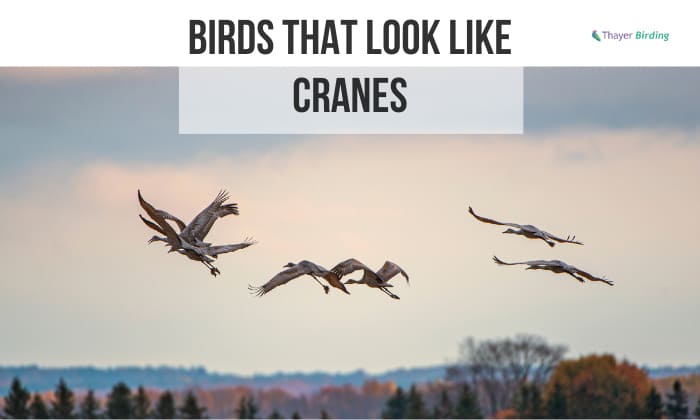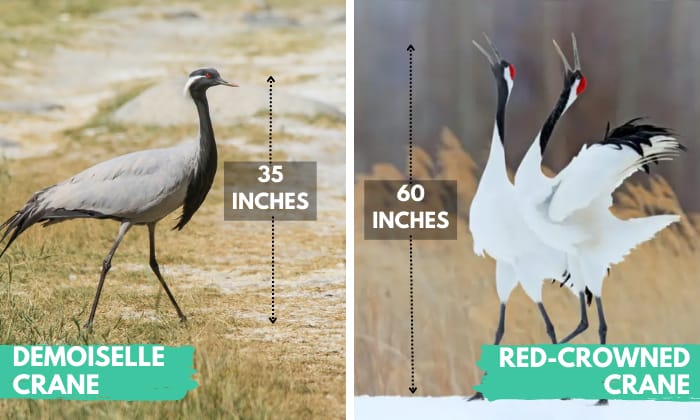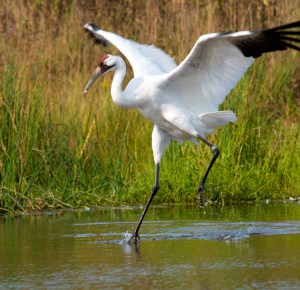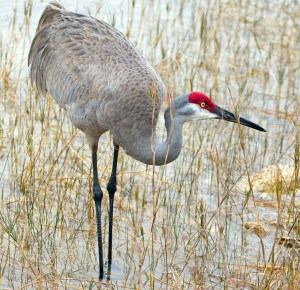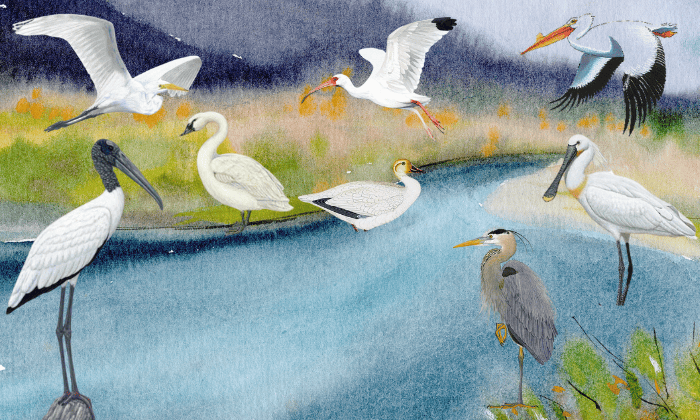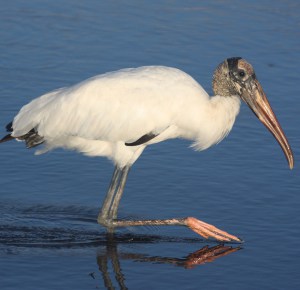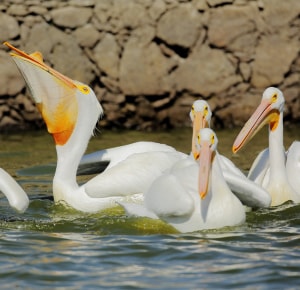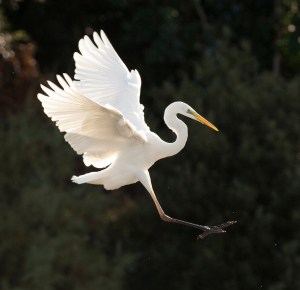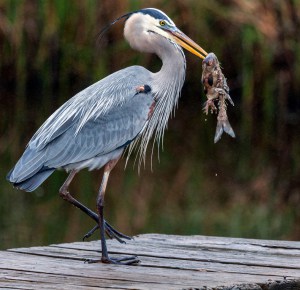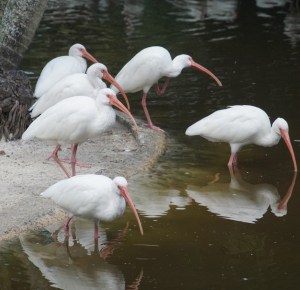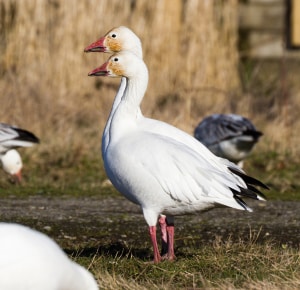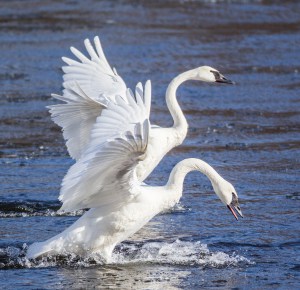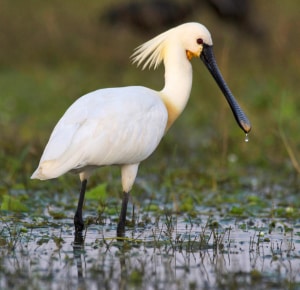It’s a bird! It’s a crane! Oh, no it’s a different species! There are lots of birds that look like cranes, so don’t feel bad if you’ve mistaken a Trumpeter Swan for a Whooping Crane.
These big tall birds bear a resemblance to egrets and herons, however, you’ll differentiate cranes from them due to their heavier and bigger bodies.
Other birds similar to cranes are Wood Stork, American White Pelican, Great Egret, Great Blue Heron, Snow Goose, and American White Ibis to name a few.
Get to know your favorite cranes, their look-alikes, size comparison, and how to differentiate them from each other.
Table of Contents
All About Cranes
Before we list down the birds that resemble cranes, let’s talk about cranes first. What does a crane bird look like?
Almost everything about cranes is long, from their neck, legs, and bills, which is not surprising to learn that they are one of the tallest flying birds.
There are different types of cranes birds, and depending on the type, the crane bird size can vary. For instance, a Demoiselle Crane has an average height of 35 inches while a red-crowned crane can be as big as 60 inches.
Cranes typically have white, gray, or brown feathers. There are also some that wear crowns like the Black-crowned Crane. The most common cranes in North America are the Sandhill Crane and the Whooping Crane, which we’ll use as the main references for this article.
1. Whooping Crane
A Whooping Crane is a large crane bird that can reach a height of more or less 5 feet.
It’s a black and white crane that breeds in Canada and flies to Texas during winter. If you’re in Texas during winter, make sure to visit the Aransas National Wildlife Refuge.
2. Sandhill Crane
The Sandhill Crane is the largest bird in Michigan which measures up to 5 feet tall.
If a Whooping Crane is a white and black crane bird, Sandhill Crane is known for having gray plumage. They are also sometimes called crane red head due to the red skin above their heads.
If you happen to see an orange crane bird, it’s probably a newborn Sandhill Crane, since its chicks tend to have an orange tint in the first few months after birth.
Below is the crane identification guide to give you a better look at what they look like and some of their look-alikes.
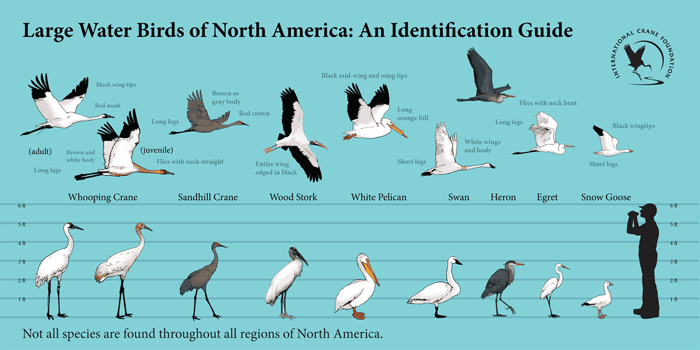
Birds Similar to Cranes
Here are some of the most similar birds with
1. Wood Stork
| Scientific Name | Mycteria Americana |
| Length | 33.5 to 45.3 inches |
| Weight | 72.3 to 93.1 oz |
| Wingspan | 59.1-68.9 inches |
| Description | Feathers are mainly white with black tails that shimmer with purplish and greenish shades. The neck and head are a scaly dark gray. |
This white bird that looks like a crane is the only bird from the Ciconiidae family that breeds in North America.
Wood Storks prefer to stay in subtropical and tropical wetlands where water levels fluctuate constantly. This North American bird also loves to build nests on trees that are enveloped with water.
- Both have long legs and necks.
- Storks and cranes are active flyers during the day.
- Cranes are omnivores while Wood Storks are carnivores.
- Storks are less social than cranes.
- Storks have webbed toes, unlike cranes.
2. American White Pelican
| Scientific Name | Pelicans Erythrorhynchos |
| Length | 50 to 70 inches |
| Weight | 123.2 to 480 oz |
| Wingspan | 95 to 120 inches |
| Description | White plumage with primary and secondary black color that can be seen when in flight. It has a big throat sac and a huge orange beak. |
The American White Pelican is considered the longest native bird and has the second-largest wingspan among North American birds. They feed mostly on fish like common carp, crayfish, salmon, catfish, and more.
In North America, you will mostly find American White Pelicans in freshwater lakes or brackish water. Other areas to spot them are the Slave River in Canada and Northwest Territories.
- Both Whooping Cranes and American White Pelicans have white plumage.
- Visible black wingtips when flying.
- S-curved necks.
- The American White Pelican’s body is much larger than Whopping Cranes, however, the latter is taller.
- During the breeding season, the American White Pelican’s bill develops a horn on its upper bill, whereas Crane’s bill doesn’t change whether it’s the breeding season or not.
3. Great Egret
| Scientific Name | Ardea Alba |
| Length | 37.0-40.9 inches |
| Weight | 35.3 oz |
| Wingspan | 52 to 67 inches |
| Description | Pure white plumage with black feet and legs. Long yellow beak that may turn to a brighter yellow during the breeding season. |
The Great Egret is known by many names such as Large Egret, Common Egret or Great White Egret. While they are commonly found in Africa, Asia, the USA, and Southern Europe, their population is now growing around Northern Europe.
This big white bird typically searches for food in shallow waters or dry areas which makes amphibians and small mammals its favorite treats.
- Both have an S-curve neck and long legs.
- Similar preferences in terms of habitat which is wetlands or anywhere near water.
- Both are monogamous and migratory species.
- A bit shorter and leaner than Sandhill Cranes.
- Their beak is yellow while Sandhill Crane’s beak is black.
- When it comes to Great Egret vs Crane plumage, the former has an all-white plumage.
4. Great Blue Heron
| Scientific Name | Ardea Herodias |
| Length | 38.2 to 53.9 inches |
| Weight | 74.1 to 88.2 oz |
| Wingspan | 65.8 to 79.1 inches |
| Description | Grayish-blue in color. The beak is long like a dagger with an orangish-yellow shade. Black feathers can be seen during flight. |
Great Blue Herons are large water birds that commonly inhabit agricultural fields, open coasts, marshes, freshwater wetlands, and riverbanks. They are typically found in Central America, North America, Southern Europe, and the Caribbean.
- Both are wading birds
- Its small head and S-curved necks are similar to Sandhill Cranes.
- Has long legs and a long beak.
- Great Blue Herons are grayish-blue while Sandhill Cranes are all gray with a few tan feathers.
- Great Blue Herons’ bill is orangish-yellow but Sandhill Cranes are black.
- Red crown for Sandhill Cranes and black crown for Great Blue Herons.
5. American White Ibis
| Scientific Name | Eudocimus albus |
| Length | 21 to 28 inches |
| Weight | 21 to 44.48 oz |
| Wingspan | 8.1 to 12.2 inches |
| Description | Has pink skin and legs with white feathers. The red-orange beak is long and arched. Their body is shaped like a football. |
American White Ibis is a small crane like bird that is part of the Ibis family commonly found in coastal areas of Canada and the USA. However, its range reaches the Atlantic Coasts, Central America and Mexico.
This pink-skinned bird prefers swamps, estuaries, freshwater marshes, wetlands in Florida, and mudflats as its habitat. American White Ibis loves feeding small aquatic insects, but its favorite is crayfish.
However, depending on their habitat and the availability of prey, they can change their diet.
- Both are wading birds.
- Cranes and American White Ibises have S-curved necks.
- Both of their bills are long with small heads.
- American White Ibises are smaller than cranes.
- Cranes have black legs while American White Ibises have bright pinkish-red legs.
- American White Ibises only have white plumage while cranes’ plumage varies depending on the type.
6. Snow Goose
| Scientific Name | Anser Caerulescens |
| Length | 25 to 31 inches |
| Weight | 72 to 158.4 oz |
| Wingspan | 53 to 65 inches |
| Description | Can have a white or bluish gray plumage. Those with white plumage are all white with black wing tips. |
Snow Geese are abundant in the north of Greenland, Alaska, Canada and northeastern Siberia. However, during winter Snow Geese prefer spending time in warmer areas of North America, the USA, and Mexico.
Since these birds are herbivores, they forage on leaves, roots, grasses, oats, corn, and winter wheat. So, it’s no wonder that you’ll also find them in agricultural fields.
- Share the same color patterns with Whooping Cranes.
- Both share the same habitats.
- Snow Goose is smaller and their body shape differs from Whooping Cranes.
- When in flight, cranes usually fly in an irregular V pattern, while Snow Geese fly in an almost perfect V pattern.
- Snow Geese also honk when in flight and cranes usually make a high-pitched squeak.
7. Trumpeter Swan
| Scientific Name | Cygnus Buccinator |
| Length | 54 to 62 inches |
| Weight | 272 to 448 oz |
| Wingspan | 72.8 to 98.4 inches |
| Description | Pure white plumage. Legs can be grayish-pink, yellowish gray, and black. Large black convex bill. |
Trumpeter Swan is the largest bird or waterfowl existing in North America. Their breeding grounds are clean and fresh wetlands, shallow ponds, marshes, and calm lakes. You can find a large number of breeding pairs in Alaska.
Trumpeter Swan’s diet consists mainly of aquatic plants and insects. They swim while they search for food which is usually underwater plants.
- Both are large waterfowl.
- The plumage is similar to Whooping Cranes
- Cranes have longer legs than Trumpeter Swans.
- Bill is shorter compared to Cranes.
8. Eurasian Spoonbill
| Scientific Name | Platalea Leucorodia |
| Length | 31.50 to 35.4 inches |
| Weight | 38.80 to 70.55 oz |
| Wingspan | 45.3 to 53.15 inches |
| Description | Pure white except for the yellow patch on the breast. Black legs and beak with a yellow tip. |
This white bird with black tipped wings is typically found in Africa, Europe, and Asia. It feeds on aquatic insects, frogs, small fish, mollusks, worms, newts, leeches, and crustaceans.
If you wish to see some Eurasian Spoonbills, check out their favorite spots such as mangroves, rivers, marshes, and lakes.
- Black legs are similar to Sandhill Cranes.
- Black wingtips when in flight.
- S-curved necks.
- Crane’s beak is like a dagger while a Eurasian Spoonbill’s beak is flat with a yellow tip.
- Eurasian Spoonbill is mostly white while cranes can be white, gray, and brown.
Conclusion
Were you able to differentiate the birds mentioned above from Whooping Cranes and Sandhill Cranes? Next time you see these birds in real life or even picture of cranes bird, we hope that you’ll be able to identify them.
Also, when you encounter a crane-like bird crossword clue, just check out the name of birds listed here and you’ll be able to find the right answer.

George and I became friends after a birdwatching trip with our new group. And we have been enjoying every adventure together. When he told me the idea of establishing a site that shares our experiences and fun, I immediately agreed. After trials and errors, here we have Thayerbirding.


